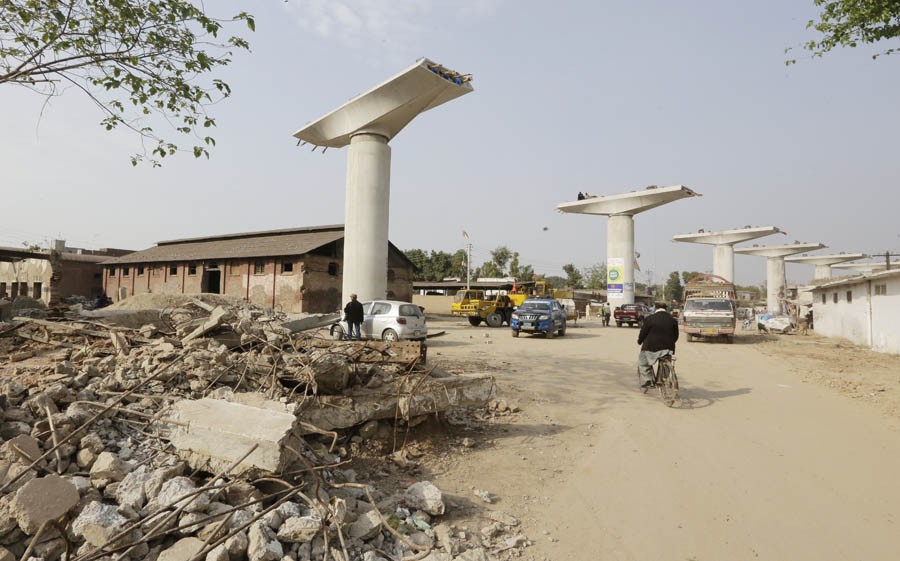
It was state-backed Nespak that did Orange Line’s feasibility study, EIA assessment and cost estimation. Is it justified?

The recent news that two Nespak employees had been charged with corruption for giving a go ahead to faulty pillars of the Orange Metro Train did not come as a surprise as financial corruption pervades our society. However, it raised two questions: one, what does one call flagrantly false analysis, doctored feasibility and cut & paste reports if not corruption? Two, can the state be made accountable if it indulges in such behaviour?
Let’s start with the feasibility of the Orange Metro Train which was done by Nespak at the request of the Punjab government. While the originally designed Orange Metro Train with 7.06-km bored tunnel from Chauburji to Sultanpura and the rest elevated had a cost of $2 billion, Nespak’s new feasibility with elevated and cut and cover solution was a much lower $1.62 billion. But, interestingly, at the request of the Punjab government, Nespak did not include land acquisition costs in the feasibility, which later came out to be Rs21.46 billion as the new design required extensive demolitions and displacements in the older parts of the city which would have been untouched in the original bored tunnel design.
The costs for transfer of services infrastructure including that of WASA, SNGPL, LESCO constitute another Rs7.4 billion, which was also not included earlier.
Even better were the benefits which Nespak calculated as much higher than the original design benefits even though the Orange Line was no longer connected to either the Green Line (now Metro Bus) or the Railway Station as earlier conceived. In the original design, 17 per cent of the Orange Metro passengers were transfer passengers from Green Line (now Metro Bus). But for Nespak, losing almost one-fifth of these commuters because of disjointed lines meant more benefits rather than less. Interestingly, this feasibility was approved by various provincial and federal bodies.
Let’s move further and take a look at the Environment Impact Assessment (EIA) report for the project which was also done by Nespak. The brilliance of this report is that it answers absolutely none of the questions that an EIA is meant to because it is 80 per cent cut and paste. The demographic data for Lahore is taken from the 1998 census. Further, the report does not include the Orange Metro alignment, and thus does not indicate exactly which properties will be demolished and citizens displaced. It mentions the number of trees to be cut but does not mention the number of citizens who will lose their livelihood and their homes.
This defeats the very purpose of conducting an EIA, which is to evaluate and choose the best option that will have the least environmental and social costs. Instead, Nespak chose to keep under cover the tens of thousands who would be adversely impacted as just 8,000 were displaced from their homes in Purani Anarkali alone.
This saga does not end here as it was Nespak’s vibration analysis, which stated that no heritage site was at a risk of damage. But a closer look at Nespak’s analysis shows that it is blatantly wrong. For example, the actual distances are 21 feet shorter for elevated viaduct than that used to calculate the vibrations because Nespak calculated this distance from the centre of the pillar rather than the edge of the pillar’s base which is the actual source of vibration to heritage sites. Similarly, the actual distance for cut & cover section is 15 feet shorter.
Further, Nespak did absolutely no building assessment which was required to set a safety threshold for every building while using the safe vibration threshold which was much higher than used internationally for antiquities and fragile buildings such as Lakshmi building, Chauburji etc. Instead, Nespak made an argument that vibrations levels are safe for all buildings irrespective of their specific condition while never providing the actual vibration levels for construction equipment. But when vibration levels are actually calculated using the right distances, they indicate levels far higher than safety threshold.
The question thus arises whether Nespak, which has thousands of engineers, is incompetent or under duress. In this particular case, its client happens to be the government of Punjab which is run by the same political party as the federal government, whose civil servants lead the board as well as the management of Nespak. Thus Nespak is just a tool which simply does its master’s bidding.
How would then one judge the Punjab government that has steam-rolled all necessary requirements of feasibility, environmental assessment, heritage impact assessment etc? Further, it has deliberately strengthened its fait accompli argument by continuing to use public money on the section of the project which will have to be undone if the Supreme Court upholds the Lahore High Court’s decision.
The question thus is quite simple. Does breaking professional ethics and bypassing due process equal corruption even if it does not involve financial gain? Stated inversely, is fait accompli acceptable?